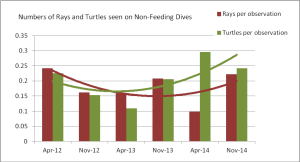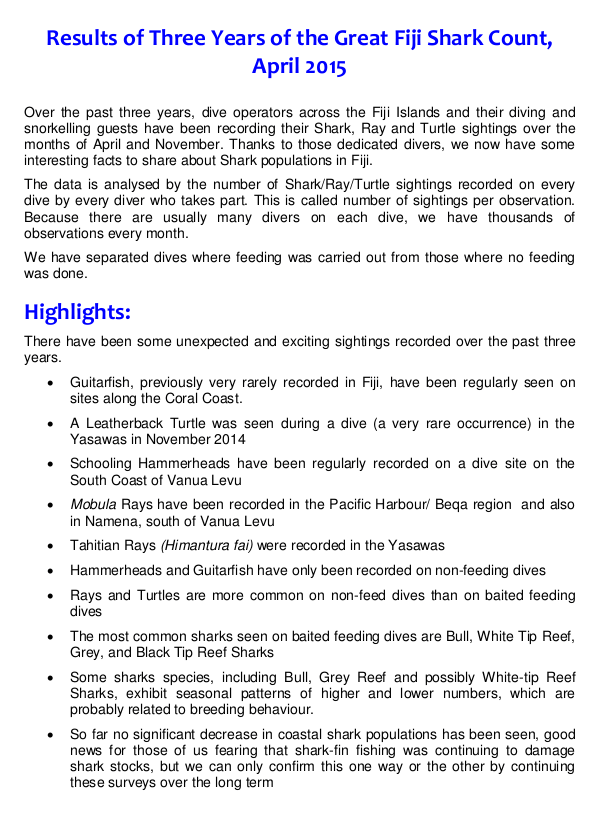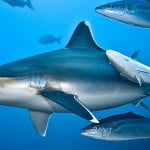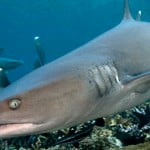Average Numbers of animals per dive during each count
Over the years, across Fiji, divers have seen an average of 1.22 to 2.03 Sharks on every dive, plus one Ray and one Turtle every 5 to 10 dives.
Shark sightings varied year by year, but the general trend appears stable or slightly increasing.
Ray and Turtle sightings appear to be very stable.
Average Numbers of each Shark Species per dive over 3 years
The most common sharks seen on Non-Feeding dives are White-tip Reef and Grey Reef Sharks.
Large schools of Scalloped Hammerheads are regularly recorded in a single location, but are only occasionally seen elsewhere.
Other species seen uncommonly but reliably in certain locations are Black-tip Reef Sharks, Tawny Nurse Sharks, Leopard Sharks and Guitarfish.
Very occasionally encountered are Silvertip, Bull, Tiger and Lemon Sharks.
Great Hammerheads are very rarely confirmed.
Patterns of each Shark Species per dive during each count
Grey Reef Sharks (dark grey line) show a pattern of higher numbers every November and lower numbers every April, which may be related to seasonal breeding activities.
White-tip Reef Shark (orange line) numbers appear to be slightly declining over the time of the surveys, particularly in 2014.
No other obvious patterns can be seen. Scalloped Hammerhead (light blue line) sightings are greatly affected by the number of dives done in their schooling location during the survey period.
Grey Reef Sharks (dark grey line) show a pattern of higher numbers every November and lower numbers every April, which may be related to seasonal breeding activities.
White-tip Reef Shark (orange line) numbers appear to be slightly declining over the time of the surveys, particularly in 2014.
No other obvious patterns can be seen. Scalloped Hammerhead (light blue line) sightings are greatly affected by the number of dives done in their schooling location during the survey period.
Average Numbers of Rays and Turtles per dive during each count
Yes
Average Numbers of each Ray or Turtle Species per dive over 3 years
No specific patterns or changes in species population over time were seen.
The most common Rays and Turtles seen on Non-Feeding Dives were:
- Hawsksbill Turtles
- Bluespotted Ribbontail Rays
- Green Turtles
- Reef Manta Rays
- Spotted Eagle Rays
- Bluespotted Stingrays
- Giant Reef Rays (uncommonly)
Three species not included in the survey lists were also recorded;
- Mobula Rays
- Tahitian Rays
- Leatherback Turtle.
Results on Non-Feeding Dives
Number of Participants ~ Non-Feeding Dives
|
Non-Feeding Dives |
April 2012 |
Nov 2012 |
April 2013 |
Nov 2013 |
April 2014 |
Nov 2014 |
|
Numbers of Dive Operators participating |
23 |
14 |
15 |
17 |
11 |
11 |
|
Number of Dives recorded |
808 |
491 |
512 |
740 |
373 |
719 |
|
Number of total Observations (every diver taking part) |
3,388 |
1,982 |
2,642 |
3,816 |
1,798 |
3,505 |
Total number of Species ~ Non-Feeding Dives
|
Non-Feeding Dives |
April 2012 |
Nov 2012 |
April 2013 |
Nov 2013 |
April 2014 |
Nov 2014 |
|
Number of Shark species |
11 |
7 |
10 |
9 |
10 |
9 |
|
Number of Ray species |
5 |
5 |
4 |
5 |
4 |
6 |
|
Number of Turtle species |
2 |
2 |
2 |
2 |
2 |
3 |
Total Numbers of Animals ~ Non-Feeding Dives
|
Non-Feeding Dives |
April 2012 |
Nov 2012 |
April 2013 |
Nov 2013 |
April 2014 |
Nov 2014 |
|
Total number of Sharks |
4,197 |
3,642 |
2,731 |
4,650 |
3,646 |
5,591 |
|
Total number of Rays |
821 |
320 |
420 |
793 |
176 |
778 |
|
Total number of Turtles |
765 |
303 |
288 |
783 |
532 |
849 |
Average Numbers of Animals per Observation (per diver per dive) ~ Non-Feeding Dives
|
Non-Feeding Dives |
April 2012 |
Nov 2012 |
April 2013 |
Nov 2013 |
April 2014 |
Nov 2014 |
|
Sharks seen per observation |
1.24 |
1.84 |
1.03 |
1.22 |
2.03 |
1.60 |
|
Rays seen per observation |
0.24 |
0.16 |
0.16 |
0.21 |
0.10 |
0.22 |
|
Turtles seen per observation |
0.23 |
0.15 |
0.11 |
0.21 |
0.30 |
0.24 |
Commonness of Shark Species most commonly seen ~ Non-Feeding Dives
(Average numbers of animals per dive)
|
White-tip Reef |
Silvertip |
Nurse (Tawny) |
Lemon (Indo-Pac) |
Leopard /Zebra |
Black-tip Reef |
|
|
Apr-12 |
0.647 |
0.018 |
0.055 |
0.014 |
0.004 |
0.084 |
|
Nov-12 |
0.667 |
0.007 |
0.005 |
0.000 |
0.000 |
0.038 |
|
Apr-13 |
0.632 |
0.003 |
0.002 |
0.003 |
0.004 |
0.143 |
|
Nov-13 |
0.687 |
0.001 |
0.008 |
0.000 |
0.012 |
0.024 |
|
Apr-14 |
0.592 |
0.013 |
0.001 |
0.000 |
0.019 |
0.016 |
|
Nov-14 |
0.440 |
0.001 |
0.009 |
0.000 |
0.005 |
0.026 |
|
Average |
0.611 |
0.007 |
0.013 |
0.003 |
0.007 |
0.055 |
|
Grey Reef |
Bull |
Tiger |
Scalloped Hammerhead |
Great Hammerhead |
Guitarfish |
|
|
Apr-12 |
0.192 |
0.061 |
0.001 |
0.161 |
0.000 |
0.001 |
|
Nov-12 |
0.801 |
0.001 |
0.000 |
0.319 |
0.000 |
0.000 |
|
Apr-13 |
0.211 |
0.026 |
0.005 |
0.006 |
0.000 |
0.000 |
|
Nov-13 |
0.468 |
0.001 |
0.000 |
0.018 |
0.000 |
0.001 |
|
Apr-14 |
0.224 |
0.000 |
0.001 |
1.159 |
0.001 |
0.002 |
|
Nov-14 |
0.648 |
0.017 |
0.000 |
0.442 |
0.000 |
0.008 |
|
Average |
0.424 |
0.018 |
0.001 |
0.351 |
0.000 |
0.002 |
Full Report Results of Three Years of the Great Fiji Shark Count, April 2015 
Download pdf Full Report Results of Three Years of the Great Fiji Shark Count, April 2015





















